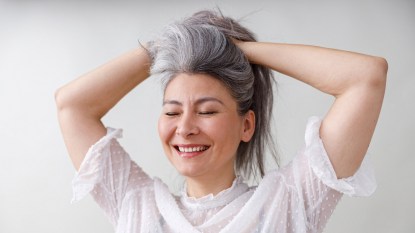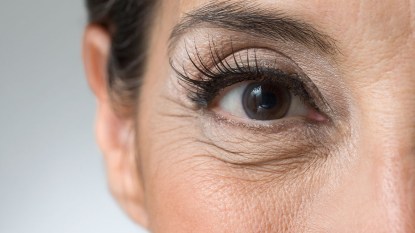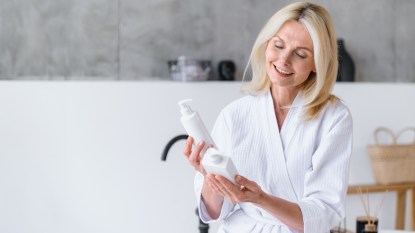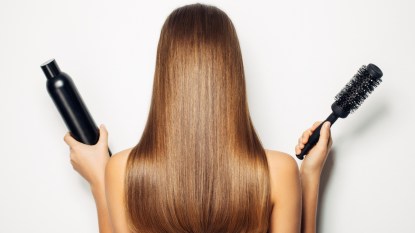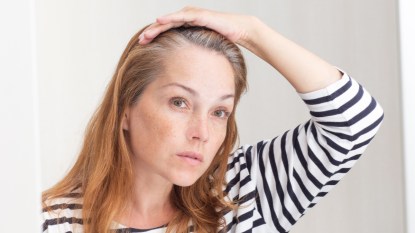Top Dermatologists Say A Common Sleep Aid Can Also Reverse Thinning Hair
When applied topically, melatonin can lead to dramatic hair regrowth
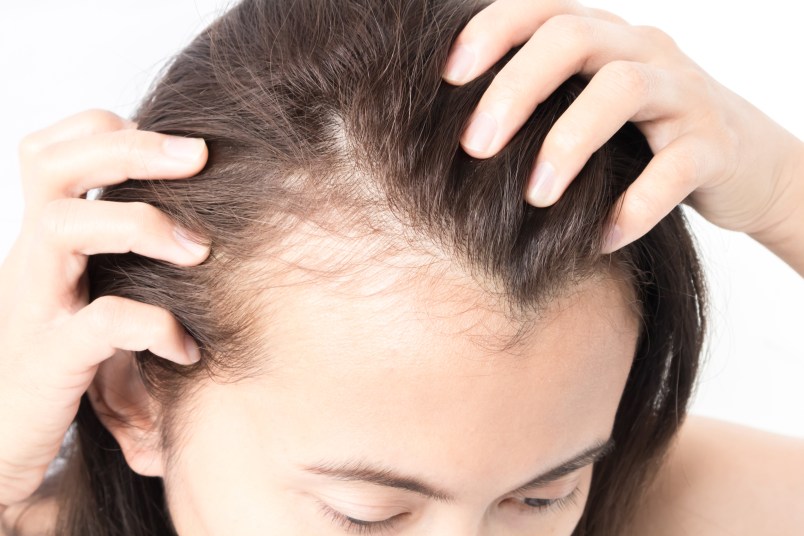
Have you noticed more hair in the drain after taking a shower? Or maybe your ponytail is getting thinner and thinner? While many of us consider hair loss to be a men’s health problem, more than half of women over 50 complain that thinning hair is sapping their confidence. And while losing your hair can do a number on your self-esteem, the good news is that it’s not necessarily permanent. In fact, a growing body of evidence suggests that the sleep supplement melatonin can encourage hair growth — naturally.
Below, we take a closer look at melatonin and explain how it can be used to reverse thinning hair.
What is melatonin?
Melatonin is a hormone produced by the body. It helps regulate your sleep-wake cycle.
“When the sun sets, melatonin builds up in your brain, signaling to your body that it’s time to go to sleep,” explains Jose Diego Mier, MD, a board-certified dermatologist and the founder of the Heliotherapy Research Institute. “That’s why you get tired when it’s dark outside.”
Melatonin doesn’t cause you to fall asleep, but it helps prepare you, by telling your body’s systems to slow down. Light has the opposite effect. It blocks melatonin production so you can function during the day.
How does melatonin encourage hair growth?
Some people who’ve taken melatonin to help them sleep have noticed an interesting ‘side effect:’ Their hair gets thicker. When researchers looked into this, they discovered that hormones like melatonin do affect hair follicles — according to a study published in the International Journal of Molecular Sciences.
Through this and other similar studies, scientists made two interesting discoveries:
1. Melatonin protects the hair follicles
“Melatonin is a powerful antioxidant and can be used to protect hair follicles from oxidative stress, such as exposure to pollution or ultraviolet (UV) radiation,” explains Dr. Mier. “The underlying mechanism isn’t fully understood, but it seems to promote hair growth and stimulate hair follicles.” Both are factors that increase hair volume and thickness. Scientists have witnessed these protective benefits in the lab.
One study of 60 people with androgenic alopecia (male pattern baldness) found that topical melatonin caused a significant reduction of hair loss in women.
Another observational study found similar results. After using topical melatonin for 30 to 90 days, participants reported a significant reduction in the severity of their hair loss.
2. Melatonin stimulates hair growth
“Stimulation of hair follicles is another potential explanation for melatonin’s positive effect on hair,” Dr. Mier says. “The presence of melatonin receptors in the scalp suggests that this hormone plays a role in hair cell growth.”
Hormones regulate many bodily functions, including the hair growth cycle. Hair growth occurs in three stages — growth, transitional and rest. Different hormones regulate each stage of this cycle. One, called dihydrotestosterone (or DHT), shrinks hair follicles and shortens the growth cycle, which can result in hair loss. This is where melatonin might help. According to Dr. Mier, “melatonin may act as a counter to DHT,” slowing or preventing hair loss altogether.
Scientists have confirmed this theory. One study, published in the journal PureJ, found that melatonin increased the volume of dermal papilla (which are responsible for hair formation) and induced hair growth by increasing the activity of genes that help hair cells grow.
How does melatonin compare to other products for hair growth?
One of the most popular topical products used to encourage hair growth is Rogaine.
“Minoxidil, which is the active ingredient in Rogaine, is the first product approved by the FDA to be used topically for thinning hair,” says Francesca Fusco, MD, assistant clinical professor of Dermatology at Mt. Sinai Hospital, in New York City. “It’s clinically proven to regrow hair, but it doesn’t work for everyone or for all types of hair loss.”
Specifically, minoxidil works by “waking up” the hair follicles and stimulating the hair cycle, so you can grow thicker, fuller hair.
“There is evidence to support melatonin’s use to support scalp hair growth with topical application. It may extend the growth phase, resulting in faster hair growth,” Dr. Fusco adds. “But I’m not aware of any, (and please excuse the pun) head-to-head studies comparing the results.”
What is the best melatonin supplement for hair growth?
You can take melatonin orally, via supplements. But you can also can apply a melatonin-infused shampoo or foam to your scalp — a strategy that’s much more effective when it comes to increasing hair growth. “I suggest considering both options and then consulting with your doctor about which suits you more,” Mier says. “She can make recommendations that align with your needs and goals.”
If you decide to go the supplement route, there are a variety of options to choose from. Anna Chacon, MD, a board-certified dermatologist and author based in Miami, Florida, recommends those made by Natrol (buy from Natrol) and Nature Made (buy from NatureMade).
“These brands have a good reputation for quality and consistency,” Dr. Chacon says. “If you prefer a topical product, DS Laboratories offers a melatonin-based hair growth treatment (Buy from DS Laboratories, $108).” It includes a shampoo, a hair-thinning treatment and melatonin-rich anti-hair loss tablets. For a more affordable topical melatonin cream, take a look at Melatonin Advanced Peptide Cream, which sells for under $30.
As with any product, it’s a good idea to read labels. Your primary care doctor is an excellent resource if you have questions or concerns. Click through for more info on melatonin supplements, including melatonin gummies.
How much melatonin should I take for hair growth?
The amount of melatonin you should take depends on several factors, including your goals and overall health. Most doctors recommend starting with a small amount (about 1 milligram) daily and increasing or decreasing the dosage based on your results.
In most scientific studies of melatonin for hair loss, topical treatments contained 0.003-0.1 percent of melatonin and the study authors noted that supplementing with 1.5 mg twice a day also appeared to help.
To see noticeable results, use the topical shampoo or foam once daily for three to six months, carefully following the directions on the label.
Can anyone take melatonin for hair growth?
Since melatonin is produced by your body, it presents few risks. But you should avoid using it if you’re pregnant or breastfeeding. Melatonin plays an important role in fetal development, but taking too much might have negative effects. As a result, it’s best to hold off until after you’ve given birth and are finished breastfeeding.
Are there other ways to increase melatonin production?
Yes. Eating melatonin-rich foods is another way to complement oral or topical melatonin supplementation. For example, you can add tart cherries or goji berries to your salads, smoothies, or oatmeal. Eggs and fish also contain melatonin, as do nuts like pistachios and almonds.
Is there anything else I should know about melatonin for hair growth?
Melatonin may promote healthier, thicker hair, but it isn’t necessarily a guarantee.
“The link between melatonin, hair growth and hair density is still a topic of ongoing research and discussion,” says Dr. Mier. “More testing and clinical studies need to be done. But from what we can see now, it’s clear that melatonin positively affects hair quality.”
This content is not a substitute for professional medical advice or diagnosis. Always consult your physician before pursuing any treatment plan.
Want more tips on how to thicken thinning hair? Check out these stories:
Want Thicker Hair? Try Science-Backed Solutions Based on the Cause of Hair Loss
Preventing Hair Loss as You Age Means Avoiding Environmental Stressors, Study Shows
Taking Too Much of This Popular Vitamin Can Cause Liver Damage, Bone Thinning, and Hair Loss



